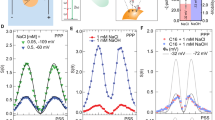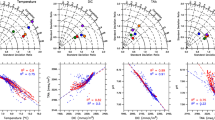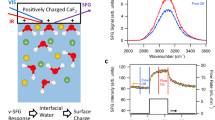Abstract
It has long been recognized that charge can affect the results of collisions in streams of water drops1,2, between drops and a flat water surface3, between two drop streams4–6, and for drops fired at suspended drops7,8. Here we present the first observations of the effect of charge on the coalescence of colliding water drops that were initially falling freely at terminal velocity. Other experiments using uncharged drops show large discrepancies between drop streams or suspended drop results and free fall, terminal velocity results9–11. Therefore, it is probable that previous work on charge effects should not be directly applied to clouds. The present findings support this contention, because the charge required to induce complete coalescence differs from previous results for similar drop sizes and size ratios by an order of magnitude. The following new features of charged drop interactions were observed: a unique impact angle dividing the coalescence from the non-coalescence region that is independent of charge, a two order of magnitude range of relative charge between drop bounce and complete charge-induced coalescence, a wide range of charge where a satellite drop occurs with temporary coalescence at higher charge levels the beginning of charge-induced permanent coalescence at the most grazing collisions.
This is a preview of subscription content, access via your institution
Access options
Subscribe to this journal
Receive 51 print issues and online access
$199.00 per year
only $3.90 per issue
Buy this article
- Purchase on SpringerLink
- Instant access to full article PDF
Prices may be subject to local taxes which are calculated during checkout
Similar content being viewed by others
References
1. Rayleigh, Lord Proc. R. Soc. 28, 406–409 (1879). 2. Goyer, G. G., McDonald, J. E., Baer, F. & Braham, R. R. /. Met. 17, 442–445 (1960). 3. Jayaratne, O. W. & Mason, B. J. Proc. R. Soc. A280, 545–565 (1964). 4. Park, R. W. thesis, Univ. Wisconsin (1970). 5. Sartor, J. D. & Abbott, C. E. J. Rech. Atmos. 6, 479–493 (1972). 6. Brazier–Smith, P. R., Jennings, S. G. & Latham, J. Proc. R. Soc. A236, 393–408 (1972). 7. List, R. & Whelpdale, D. M. /. atmos. Sci. 26, 305–308 (1969). 8. Whelpdale, D. M. & List, R. J. geophys. Res. 76, 2836–2856 (1971). 9. Beard, K. V. & Ochs, H. T. J. atmos. Sci. 40, 146–153 (1983). 10. Ochs, H. T. & Beard, K. V. /. atmos. Sci. 40, 863–867 (1984). 11. Ochs, H. T., Czys, R. R. & Beard, K. V. /. atmos. Sci. 43, 225–232 (1986). 12. Takahashi, T. /. geophys. Res. 77, 3869–3878 (1972). 13. Pruppacher, H. R. & Klett, J. D. Microphysics of Clouds and Precipitation (Reidel, Dordrecht, 1978). 14. Davis, M. H. Q. Jl Mech. appl. Math. 17, 499–511 (1964). 15. Melcher, J. R. Field–Coupled Surface Waves (MIT Press, Cambridge, Massachusetts, 1963). 16. Czys, R. R. thesis, Univ. Illinois (1987). 17. Berry, E. X. & Reinhardt, R. L. /. atmos. Sci. 31, 1814–1831, 2118–2135 (1974). 18. Ochs, H. T. & Beard, K. V. /. atmos. Sci. 42, 1451–1454 (1985).
Author information
Authors and Affiliations
Rights and permissions
About this article
Cite this article
Ochs, H., Czys, R. Charge effects on the coalescence of water drops in free fall. Nature 327, 606–608 (1987). https://doi.org/10.1038/327606a0
Received:
Accepted:
Issue date:
DOI: https://doi.org/10.1038/327606a0
This article is cited by
-
Next generation digital microfluidic technology: Electrophoresis of charged droplets
Korean Journal of Chemical Engineering (2015)
-
Bursting drops in solid dielectrics caused by high voltages
Nature Communications (2012)
-
Non-coalescence of oppositely charged drops
Nature (2009)



